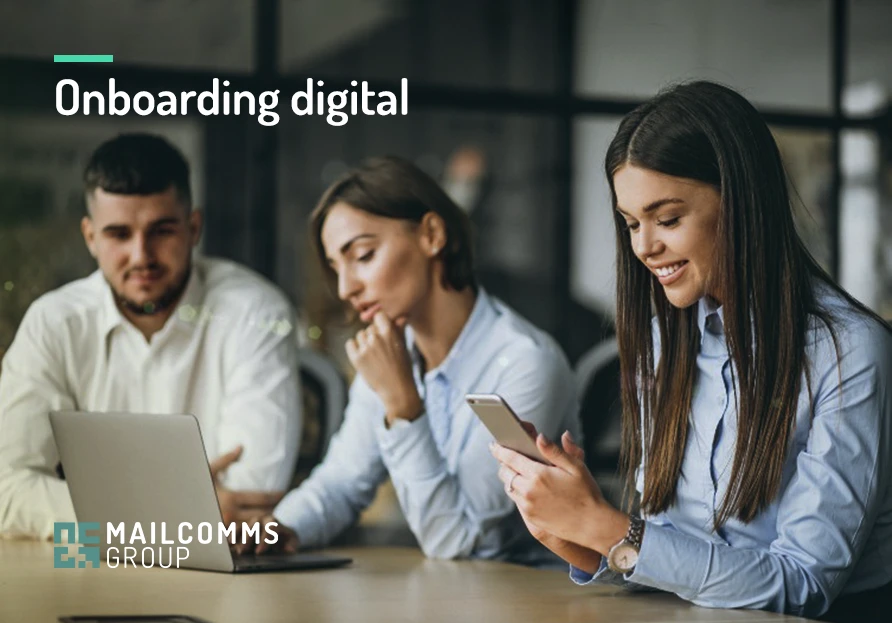When the COVID-19 pandemic hit, insurers, financial institutions, credit unions and businesses around the world had to transition to purely remote digital processes virtually overnight.
While digitalization efforts in many industries were already underway, COVID-19 undoubtedly accelerated the shift to digital-first strategies for customer acquisition, new account opening and self-service processes. This is how digitalonboarding emerged strongly as an essential component in the digital transformation of companies.
What is digital onboarding and how does it work?
Digital onboarding is the process of welcoming and integrating new employees or customers through digital tools. Instead of being done in person or with paper documents, it is carried out using online platforms that automate much of the process.
There are multiple steps in the traditional onboarding process that can be completely eliminated with the help of digital technologies, leading to a simpler and more convenient experience without compromising security.
Modern acceptance technologies, such as digital identity verification and electronic signatures, are used for this purpose.
Digitization of the welcome and adaptation processes in companies
Advances in technology have allowed traditional onboarding processes to migrate to a digital format. Companies are adopting solutions that eliminate the use of paper and physical interactions in processes such as:
- The digital signature of contracts.
- Initial training.
- Introduction to the company’s philosophy, standards and policies.
- Details of the functions of the position.
- Integration within the company’s network.
This not only streamlines the onboarding of new employees, but also ensures greater control and security.
Discover the benefits of digitization of processes in companies and how to implement it.
Automation and simplification of the onboarding process
Digital onboarding automates repetitive tasks, such as contract generation and document management. By eliminating the bottlenecks typical of the manual process, companies can significantly reduce the time required to onboard new employees or acquire new customers.
Electronic signature and digital identity identity verification solutions are key to achieving a frictionless experience.
Digital Onboarding in Human Resources: A Paradigm Shift
The implementation of digital onboarding in human resources has radically transformed how new hires are managed.
The HR can now focus more on strategy and less on the logistics of the welcome process. This is because the adoption of digital platforms not only saves time, but also allows for better tracking and personalization of the employee experience from their first contact with the company.
Efficient onboarding of new employees through digital platforms
With digital tools, onboarding new workers is much more efficient.
From the first interaction with the company, employees can complete forms, receive training and familiarize themselves with the company’s systems without the need to be physically present, since, once the applicant has been correctly identified in real time, they are presented with documents to review and sign electronically.
This is especially relevant in contexts where teleworking is the norm.

Benefits for the HR department and the employee experience
Digital onboarding in human resources offers multiple benefits to this department, highlighting:
- Significant savings in time and resources.
- Data collection to facilitate process customization and continuous improvement.
But these advantages do not stop there, because there are also advantages for employees. Digital onboarding makes it possible to optimize the relationship with employees, making the experience more agile, which contributes to a more positive start in the company.
Examples of digital onboarding in companies
Some pioneering companies that have implemented examples of digital onboarding have demonstrated the value of this process. MunichRe is a great example of a business that was able to achieve results with this process.
This company worked with partners and clients to completely reinvent the workflow of their voluntary coverage line and selected technology platforms to meet those needs. Their fully electronic process, including the electronic signature solution integrated with OneSpan Sign, allowed them to reduce onboarding time from 30 days to just 10 minutes.
Another great example is Mitchell & Whale, one of the fastest growing organic brokerages in Ontario. These adapted to the modern consumer long before COVID-19, which led them to attract a unique demographic, 50% of whom were under 40.
This success is largely due to their digital strategy, for which they carefully selected technologies that met the needs of their existing workflows.
By creating templates enabled for user-initiated e-signatures and requiring mandatory agent training, they were able to quickly digitize their strategy and simplify the process for both agents and customers.
This type of success is increasingly common, highlighting the effectiveness of digital transformation in HR.
Best practices and tools for the digital management of onboarding
There are several tools and platforms that facilitate the management of digital onboarding.
From document management solutions to online training platforms, companies must select those that best suit their needs. For example, at MailComms Group we facilitate e-recruitment in e-recruitment in companies thanks to our electronic signature services y virtual signature roomamong others.
In addition, it is important to ensure that the tools chosen integrate tracking and customization features to ensure that the process is efficient and user-friendly.
In the case of customer acquisition, whether you are starting to digitize the customer journey customer journey or you are on the path to full automation, incorporating e-signatures is an essential (and easy to implement) strategy that can reduce delays in customer onboarding and improve the customer experience.
In that regard, there are two approaches to implementing electronic signatures: user-initiated and integrated. Both provide operational efficiencies, improve customer experience and reduce document errors, but each also has distinct advantages.
The former is ideal for lower volume processes and satisfies the most common signature workflows (e.g. contracts and agreements). This is a good place to start, as absolutely no development is required; simply upload your document, select your signers and you can start signing electronically within minutes.
The second is an integrated approach designed for more complex, system-driven processes. This solution gives you the ability to add e-signature capabilities into your own applications, such as your website, mobile application or any of your systems, and create automatically generated workflows.
For a complete breakdown of the advantages offered by both approaches, see the table below:
Creation of a successful digital onboarding plan
To implement a successful onboarding plan, it is essential to identify the key elements that will make the process smooth and effective, and to take into consideration that the strategies will have to be tailored specifically to the industry and employee. Let’s take a closer look.
Key elements of an efficient digital onboarding plan
An efficient onboarding plan should include:
- Automation of repetitive tasks.
- Customization of welcome and training content.
- Electronic signature integration.
- Constant monitoring and evaluation of the process.
- Digital communication tools to solve doubts and accompany the employee.
Methodologies for adapting a plan to different industries and types of employees
Companies in all industries have already benefited from this new technology and its legislative framework. However, in order to adapt a digital onboarding plan to different industries and types of employees, it is essential to take into account the specific needs of each sector.
For example, in digitalonboarding in banking or insurance (regulated industries), it is key to integrate identity verification processes, such as KYC, to comply with legal regulations. Meanwhile, in more creative or technological sectors, a flexible approach that encourages interaction and the use of collaborative tools will be more effective.
In addition, adjusting the onboarding content according to the employee’s level of experience, from junior to senior, guarantees a personalized and effective experience, optimizing integration regardless of area or industry.
Learn more about what KYC is and how it can offer security, compliance and efficiency to your company.

Digital Onboarding: what advantages does it offer over traditional onboarding?
Digital onboarding offers multiple advantages over the traditional process. Among them are:
- Reducing the time required to complete the process (transitioning to a purely digital onboarding process can reduce a traditionally lengthy experience over days or weeks to mere minutes).
- Elimination of paper documents.
- Increased automation, standardization and process optimization.
- Ease of access from anywhere.
- Improved employee experience.
- Increased retention rates of talent or users.
- In the case of customer relationships, it facilitates the implementation of more effective direct marketing strategies.
During a OneSpan webinar, the audience (79% insurance industry professionals) was asked, “How are you currently managing new customer onboarding?”
The results indicated that nearly 85% have already adopted partial automation strategies or fully digital onboarding practices. This is a great trend to watch and we expect it to continue in the coming years.
If your company is looking for solutions to optimize digital onboarding, MailComms Group offers a complete e-recruitment platform that includes, not only digital signatures, but also certified electronic identification systems to simplify the entire onboarding process for new employees.
This solution streamlines digital onboarding, while ensuring security and regulatory compliance.
